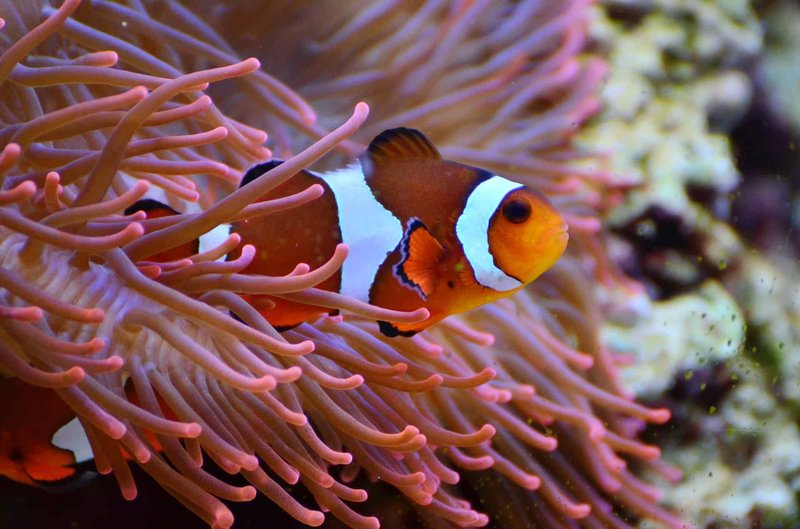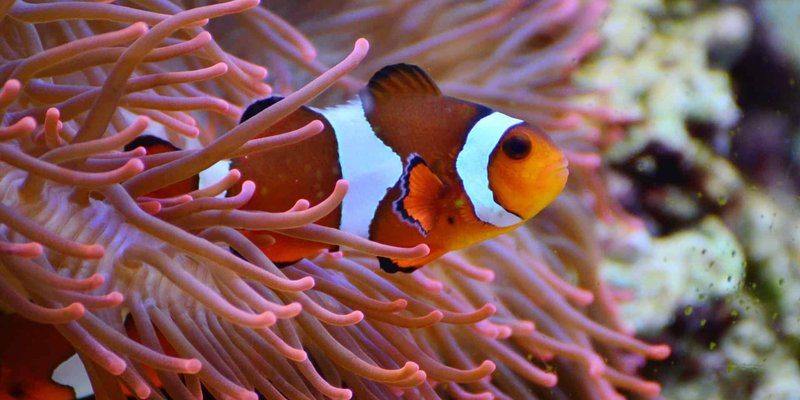
Clownfish are best known for their striking orange coloring adorned with bold white stripes. They’ve been made famous by movies like “Finding Nemo,” but there’s so much more to them than what Hollywood portrays. If you’re curious about these charming fish, let’s dive into some fun facts that will make you appreciate these little sea creatures even more.
1. Clownfish and Sea Anemones: A Match Made in Heaven
One of the coolest things about clownfish is their unique relationship with sea anemones. You might think of anemones as those colorful, swaying plants in the ocean, but they’re actually animals with stinging tentacles. So, how do clownfish manage to hang out with them without getting stung?
Here’s the thing: clownfish are born with a special mucus coating that protects them from the anemones’ stings. This is like having a built-in suit of armor! They play a crucial role in their symbiotic relationship. Clownfish provide food scraps and help keep the anemones clean, while the anemones offer a safe haven from predators. It’s a win-win situation in the bustling underwater neighborhood!
2. Clownfish Are All Male—At First!
You might be surprised to learn that all clownfish are born male. Yes, you heard that right! In each anemone, there’s a dominant female who is the breeding partner. When the female dies or is removed, the largest male will transition into a female. This sex change helps maintain the breeding pair, ensuring that there’s always a couple ready to produce little clownfish.
Imagine the dynamics in their little community! It’s a fascinating societal structure that not only ensures survival but also highlights the adaptability of these creatures in the wild. So, in a way, clownfish are like the ultimate team players, always ready to step up when needed.
3. They Speak Their Own Language
You might be wondering how clownfish communicate with each other. Unlike humans, they don’t talk, but they have their own unique way of expressing feelings. Clownfish make a variety of sounds, including popping and clicking noises, to communicate. This can signal everything from alarm to mating calls.
Think of it like a secret language that only they understand! This ability allows them to alert their partners about threats or to attract a mate. It’s a reminder that even in the underwater world, communication plays a critical role in survival and social interaction.
4. Clownfish Coloration Changes Over Time
If you’ve ever seen a baby clownfish, you might have noticed that they don’t start off bright orange. In fact, they can be quite drab in color when they hatch. Clownfish typically take on their striking coloration as they grow and mature. This change is not just for aesthetics; it helps them blend into their anemone homes and avoid predators.
So, it’s like they’re putting on their best suit for the big dance! By changing colors, they can navigate their environment better, ensuring that they remain safe while still looking fabulous. Their bright colors also serve as a warning to potential threats about their association with the venomous anemones.
5. They Have Quite the Diet
Clownfish are omnivores, meaning they eat both plant and animal matter. Their diet typically consists of algae, zooplankton, and food scraps from the anemone. You might think they wouldn’t have many options living among the anemones, but they’re pretty resourceful.
When you look closely, you’ll see that clownfish often nibble on the leftover bits of food that other fish leave behind. This scavenger behavior supports not only their diet but also the health of their environment. By cleaning up, they help keep their homes in tip-top shape—another example of their symbiotic relationship!
6. Clownfish Can Be Territorial
In the world of clownfish, it’s all about claiming your space. These fish can be quite territorial, especially when it comes to their anemones. They’ll chase away intruders, defending their home against potential threats. You might say they’re like the bouncers of the reef!
However, their territorial nature also comes with its challenges. If there are too many clownfish in one area, competition for food and space can lead to stress and aggression. This behavior is fascinating because it shows us how even the smallest creatures have complex social structures and hierarchies, akin to a bustling city.
7. Clownfish Are Found in Warm Waters
Most clownfish live in the warm, shallow waters of the Pacific and Indian Oceans. They thrive in coral reefs, where they can find plenty of anemones to call home. If you’re ever lucky enough to snorkel or dive in these regions, you might spot them darting around their anemone homes.
The climate and temperature of these waters are crucial to their survival. Warmer waters not only provide necessary nutrients but also a habitat free from freezing temperatures. This is part of what makes clownfish so unique—it’s a special touch of nature that keeps them thriving in their preferred environments.
8. Clownfish Can Live a Long Time
Believe it or not, clownfish can live quite a long time for such small fish. In the wild, they can live up to 6 to 10 years, but in captivity, some have been known to live even longer! With the right care and environment, they can thrive in aquariums.
If you’ve ever thought about keeping clownfish as pets, it’s essential to provide them with a proper setup, including an anemone or similar configuration for them to feel safe. It’s a bit like giving them a little piece of their natural habitat, which is crucial for their health and happiness.
9. They’re Important to Marine Ecosystems
Clownfish play a vital role in their ecosystems. By living in anemones, they help maintain the health of these creatures, and in return, the anemones provide a safe shelter for the clownfish. This delicate balance is crucial for the overall health of coral reefs.
In a sense, clownfish are like the unsung heroes of the reef. Their presence supports biodiversity and helps create a vibrant underwater world. Without them, the marine ecosystem would be less stable, showcasing how every creature, no matter how small, contributes to the bigger picture.
10. They’re Not Just Cute—They’re Popular!
You might have noticed that clownfish have become incredibly popular in recent years—not just in movies but also as pets. Their vibrant colors, unique behaviors, and friendly nature make them a favorite for aquarium enthusiasts.
However, it’s essential to remember that keeping clownfish requires responsibility. If you decide to adopt them, make sure you’re prepared to create a suitable environment that mimics their natural habitat. This means providing them with anemones or related structures, a stable water temperature, and a balanced diet.
In conclusion, clownfish are much more than just the stars of animated movies. From their unique relationships with sea anemones to their impressive adaptability and communication skills, they offer a glimpse into the fascinating world beneath the waves. Whether you’re contemplating keeping them as pets or simply learning about marine life, these fish remind us of the beauty and complexity of nature. So next time you think of the ocean, remember the clownfish—it’s like having a little piece of wonder right at your fingertips!

